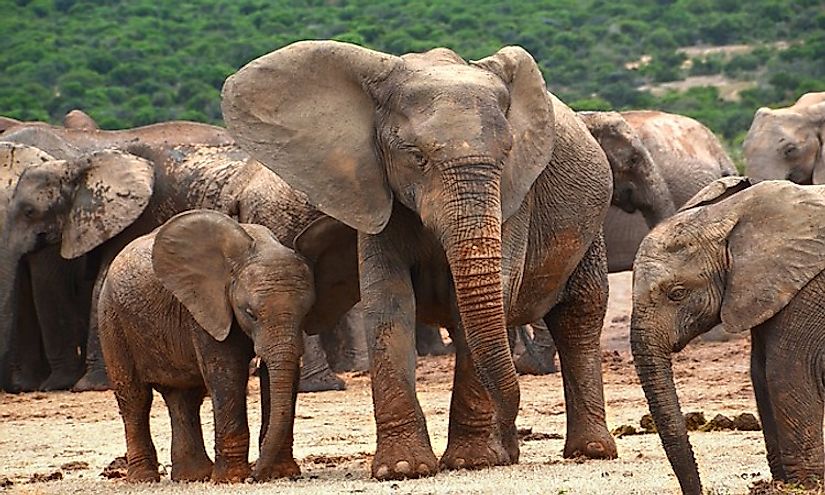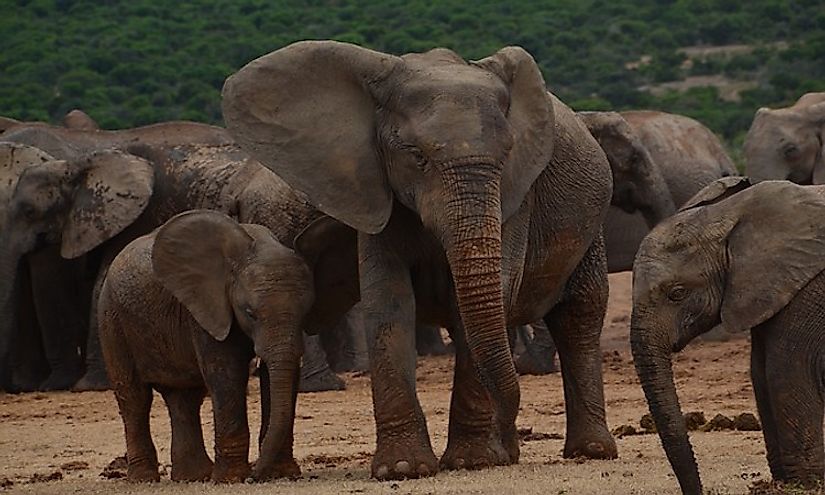How Many Types Of Elephants Are There?

9. Classification Of Elephants -
Elephants are large terrestrial mammals belonging to the family Elephantidae within the order Proboscidea. The closest extant relatives of elephants are the dugongs, the manatees, and the hyraxes. Two distinct types of elephants were recognized, the African elephant (Loxodonta) and the Asian elephant (Elephas). In 1942, the African elephants were classified into 18 subspecies, but genetic studies later recognized only two subspecies, the savannah elephant (L. a. africana) and the forest elephant (L. a. cyclotis). However, another major change in the classification of elephants came in the 21st century when DNA studies revealed that these two subspecies qualified to be treated as separate species. However, there are still debates regarding the classification of the African elephants into species and subspecies, and while some wildlife bodies recognize the bush and forest elephants as separate species, others recognize them as subspecies of the African elephant.
Asian elephants are found in South Asia and South-east Asia, and there are three types of elephants in this species: the Sri Lankan elephant, the Indian elephant, and the Sumatran elephant. Some studies also classify the Bornean elephant as a distinct sub-species.
8. African Elephant -

African elephants belong to the genus Loxodonta which has two extant species, the African bush elephant, and the African forest elephant. African elephants are the largest terrestrial animals on Earth and are famous for their massive size and intelligent behavior. Below is a description of the two species of African elephants.
7. Savannah/Bush Elephant -

The bigger of the two types of elephants found in Africa, the African bush or savannah elephant (Loxodonta africana) is more widely distributed in Africa than the forest elephant. This elephant is the heaviest and the largest terrestrial animal. The bush elephant can weigh as much as 10.4 tons and grow 13 feet tall at the shoulders. Their extremely large ears that are used to radiate excess heat is one of their most distinct characteristics. They also have longer trunks than other types of elephants and bigger tusks which are present in both sexes.
Based on minor genetic and morphological differences, there are four recognized subspecies of African bush elephants. They are as follows:
Southern African bush elephant (L. a. africana): Southern Congo, Gabon, Malawi, South Africa, Botswana, Namibia, Zimbabwe, Mozambique, Zambia, Swaziland.
Masai elephant or East African bush elephant (L. a. knochenhaueri): Kenya, Uganda, Tanzania, the Eastern Democratic Republic of the Congo, Rwanda, Angola.
African plains elephant or West African bush elephant (L. a. oxyotis): Senegal, Mauritania, Nigeria, Northern Cameroon, Ethiopia, Somalia, Liberia.
North African bush elephant (L. a. pharaohensis): Once native to Sahara now believed to be extinct.
6. Forest Elephant -

The African forest elephant (Loxodonta cyclotis) resides in the forests of the Congo basin of Africa. Though initially regarded to be the same species as the African bush elephant, genetic studies revealed significant differences between the two. Such studies also indicated that the two evolved separately some 2 to 7 million years ago. Thus they are classified as separate types of elephants.
The African forest elephants are darker and smaller than their savanna counterparts. Their ears are also more rounded and smaller in size. The mandible is narrower, and the tusks are stronger and straighter than the savannah species. The strong tusks, sometimes reaching to the ground, are used to push through the dense undergrowth of the elephant’s habitat. Unlike the savannah species, the forest elephant has five toenails on the forefoot and four on the hindfoot. Since these elephants have a slower birth rate, they take a longer time to recover from poaching than the bush elephants.
5. Asian Elephant -
The only living species of the Elephas genus, the Asian elephant (Elephas maximus), one of the two major types of elephants, is distributed across Asia from the Indian subcontinent to Southeast Asia. In general, Asian elephants are larger than the African elephants. The highest point of the Asian elephant is located on the head. Unlike the African elephants, they have a twin-domed head that bears an indent to the middle. The Asian elephants have convex or level back. The ears of these elephants are smaller than those of their African counterparts since they live in a cooler habitat. Asian females lack tusks and males may or may not bear tusks. More nail-like structures are present on their feet than the African elephants.
4. Sri Lankan elephant -

The Sri Lankan elephant (Elephas maximus maximus) is one of the three subspecies of the Asian elephant that lives in Sri Lanka. These elephants are the largest among the Asian elephant subspecies and reach a shoulder height of 2 to 3.5 m, weight between 2,000 and 5,000 kg, and possess 19 pairs of ribs. The Sri Lankan elephants are darker than the other two subspecies and the depigmentation patches on their skin are more distinct than that of the others. Only 7% of the male Sri Lankan elephants bear tusks.
The elephants are classified as endangered since their population has drastically declined over the past century and their range is also highly restricted due to high levels of deforestation.
3. Indian elephant -

Native to mainland Asia, the Indian elephant (Elephas maximus indicus) is one of three subspecies of the Asian elephant. This type of elephant attains a shoulder height of 2 to 3.5 m, weigh between 4,000 and 5,000 kg, and possess 19 pairs of ribs. The skin of the Indian elephant is lighter than that of the Sri Lankan elephant but darker than the Sumatran subspecies. Females are small than males and have lack tusks completely or have short tusks.
The Indian elephants are currently classified as endangered by the IUCN. Poaching, habitat loss, deforestation, habitat fragmentation, persecution by humans, and road and rail accidents threaten the survival of these elephants.
2. Sumatran elephant -

Native to the island of Sumatra, the Sumatran elephant (Elephas maximus sumatranus) is a subspecies of the Asian elephant. These elephants grow to achieve a shoulder height between 2 and 3.2 m and weigh between 2,000 and 4,000 kg. The elephants possess 20 pairs of ribs and differ from the other two Asian elephant subspecies in having a lighter skin color. Habitat loss, deforestation, and fragmentation, as well as poaching, threaten the survival of the Sumatran elephant. They are critically endangered according to IUCN.
1. Borneo elephant -

The Borneo elephant is found in the northern and northeastern sections of the island of Borneo in Malaysia and Indonesia. The origin of these elephants is a matter of debate, and there are claims that these elephants could have evolved from the captive elephants introduced to Borneo by the Sultan of Sulu. Currently, the classification of the Borneo elephant is not yet definitive, and further genetic and morphometric studies might be able to generate sufficient data to definitively classify it as Elephas maximus borneensis.
Though the Borneo elephants are referred to as “pygmy elephants” no significant difference in size, have been found between these elephants and the ones in peninsular Malaysia. However, the Borneo elephants are remarkably tame and passive, another indication that these elephants are derived from a domestic stock.











